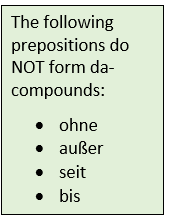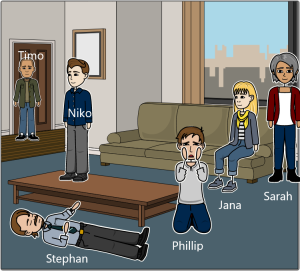17 Proficiency Interviews 4
PI-4: Da-compounds (introduction)
You’ve been using accusative prepositions, dative prepositions, and two-way prepositions to form sentences.
Ich habe einen Schreibtisch. Mein Bett steht neben dem Schreibtisch.
(I have a desk. My bed stands next to the desk.)
In everyday life, when we refer to the same object multiple times, we often substitute pronouns in for nouns. If we were to substitute Schreibtisch in the last sentence with a pronoun, it would look like this.
Ich habe einen Schreibtisch. Mein Bett steht neben ihm.
German has a shorter way of using pronouns that come after prepositions.
Ich habe einen Schreibtisch. Mein Bett steht daneben.
daneben = next to it
We add da to the preposition, and it ends up translating to “it.”
- da + durch = dadurch = through it
- da + für = dafür = for it
- da + gegen = dagegen = against it
- da + bei = dabei = at it, near it
- da + mit = damit = with it
- da + nach = danach = after it
- da + von = davon = from it, of it
- da + zu = dazu = to it
- da + neben = daneben = next to it
- da + hinter = dahinter = behind it
- da + vor = davor = in front of it
- da + zwischen = dazwischen = between it/them
A: Wo ist dein Mann?
B: Siehst du die zwei blauen Autos dort drüben? Er steht dazwischen.
The good news is that when you use these da-compounds, you don’t have to decide what case they are; you simple add da to the beginning and that’s it!
If the preposition begins with a vowel, we add an extra –r– between the da and the preposition.
- da + um = darum = around it

- da + aus = daraus = out of it
- da + an = daran = at it, toward it, on it (vertical)
- da + auf = darauf = on it
- da + in = darin = in it
- da + über = darüber = above it, about it, over it
- da + unter = darunter = under it, beneath it
You will learn more about these in later German courses, but for now, try to use them when describing where things are located. It gives the German you already know an advanced boost.
Ex. A: Wo ist er? A friend wants to know where the following people are located. Using an object as orientation, tell her where each person is standing in relation to it by using a da-compound.

Beispiel: Niko
A: Wo ist Niko?
B: Siehst du den Tisch?
A: Ja, ich sehe ihn.
B: Nico steht darauf.
Ex. B: Beschreiben Sie Ihr Zimmer! Describe your room using both two-way prepositions and da-compounds
Ex. C: Nicos Weg. Episode 60: Schick!

